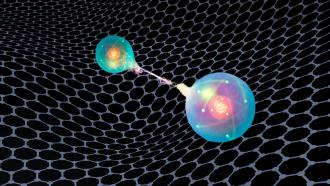
Researchers at Raman Research Institute, Bengaluru, are exploring the properties of single walled carbon nanotube (CNT) immersed in aqueous triblock copolymer solution. The newly formed CNT-polymer hybrid could replace the use of carbon nanotubes by itself, thanks to its remarkable mechanical, thermal and electrical properties.
Carbon nanotubes (CNT) are cylindrical tubes made by rolling up a single sheet of carbon atoms called graphene, and with a diameter of only a few nanometers. They are the strongest and stiffest material discovered yet, and also perform remarkably as a thermal and electrical conductor, with very little resistance. This has made CNT a much sought-after material in engineering and material designing. However, when immersed in water or a solution, due to their hydrophobic (repel water) nature, they clump together in the solution. This clumping together compromises some of the beneficial properties of the material, as bulk CNT is not as strong as individual tubes. Scientists overcome the limitation by chemical and physical modifications of the nanotubes.
In the new research, scientists wanted to study one such chemical modification of the carbon nanotubes, by immersing them in polymers—by immersing them in an aqueous solution of triblock copolymer. Copolymers are large molecules formed by joining repeating subunits of monomer molecules. A triblock polymer is made of repeating monomers that can be divided into three unique parts of the constitutional units. Strands of CNT were immersed in an aqueous solution of a triblock copolymer. Once immersed, “the single-walled carbon nanotubes in this system aggregate to form bundles, and the bundles aggregate to form net-like structures” explain the authors.
The CNT-polymer hybrid was then subject to different tests, including scanning electron microscopy (SEM), differential scanning calorimetry (DSC), small angle X-ray scattering (SAXS), electrical conductivity, and H NMR studies, at different temperatures.
The studies reveal the formation of three distinct self-assembled CNT-polymer hybrids, depending on the temperature and phases of the polymer. “We find CNT-unimer (a type of polymer belonging to a certain group) hybrid at low temperatures, CNT-micelle (colloidal solution) hybrid at intermediate temperatures wherein the polymer micelles are adsorbed in the pores of the CNT nets, and another type of CNT-micelle hybrid at high temperatures wherein the polymer micelles are adsorbed on the surface of the CNT bundles” reveal the authors about the results. Interestingly, the researchers also noted the formation of cone-shaped and cube shaped formation of the polymer micelles adsorbed on the CNT nets, at different temperatures. The researchers further went on to study the properties of the three hybrids.
By studying the properties of the hybrid material, the study opens up further ways to enhance the already remarkable properties of CNTs, and could also reveal new and interesting features of the hybrid material, in the future.






